|
This is the second summer email, offering yet another 'short story',
Written for Sharing with our 'Smaller Citizens', and those just 'Young at Heart' :
'LATE SEPTEMBER STORIES' : A TALE OF TAPERSTICKS
(And, Sealing Wax)

"'The time has come,' the Walrus said,
'To talk of many things:
Of shoes - and ships -
and sealing-wax ...
and cabbages and kings,
And why the sea is boiling hot -
And whether pigs have wings.'"
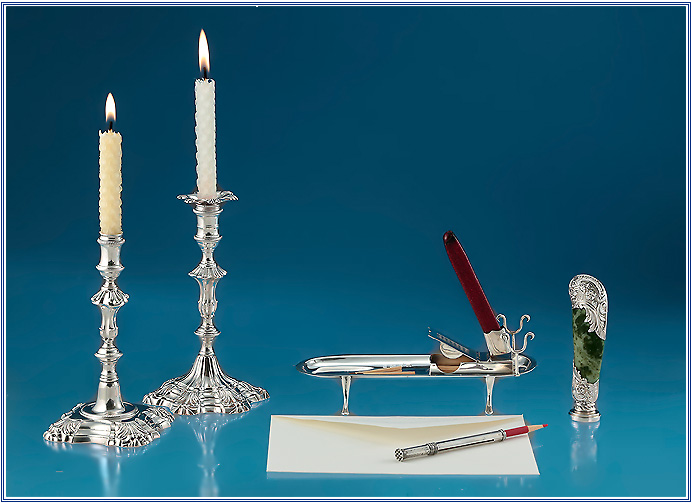
Says the Walrus to the Carpenter (as the oysters listened on) :
"Now, when is a candlestick not a 'stick',
To light my way along?"
The Carpenter replied without a pause, knowing he's not wrong :
"Why, when it is a
TAPERSTICK and sings a different song."
"And when's a candle not a candle,
And tall and straight and strong?"
"When it is scented
'sealing-wax' and
MELTED FLAT belongs."
Meanwhile the oysters
all agreed, as they tried to sneak back home.*
Before computers and typewriters,
most of us used to write letters - with pen - on paper.
And before the Post Office and FedEx,
those letters - simply folded - were delivered, by hand, by special couriers.
To keep one's letters private - be they secret love letters or the latest gossip -
a special
"sealing wax" was heated, dropped onto the folded document,
then stamped with a
hand-held
"seal"
or signet ring.
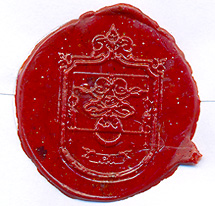
This practice of sealing messages has been around since very ancient times.
As well, important official documents issued by kings, queens, popes, and governments
were (and still are) authenticated by personal or state
impressed wax "seals".
Below is a
golden signet (sealing) ring
with the name, inscribed in hieroglyphics, of
Tutankhamen, Pharaoh of Egypt from c1333 c1325 BC - about 3,300 years ago.
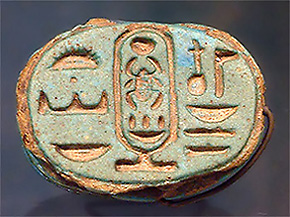
(The
Louvre, Paris)
ABOUT SEALING WAXES :
The Egyptians used clay to secure the papyrus
documents, as did the Greeks.
The Romans first sealed a sticky black
asphalt-like material that hardened when exposed to air.
Later, they began use of
the more pliable (and pleasant) beeswax
for sealing.
Thus, beeswax continued as sealing wax of choice throughout the Middle Ages.
During this period, "beeswax" was even
thought to be "holy" -
as bees were considered blessed by God.
The Vatican ordered only beeswax to be burned in religious services.
Below are three surviving Middle Ages beeswax
candles, dating to the 6th century :
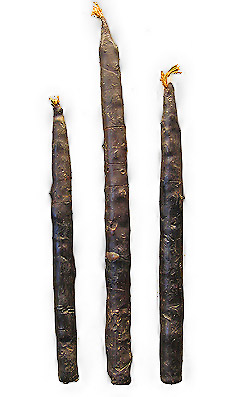
Beeswax was the sealer for the next 1100 years - until about 1600 -
when "varnish-makers" began to blend special "sealing waxes" which, for a time,
contained no wax at all!
Most were based on furniture polishing formulas (shellacs, varnishes, lacquers, etc.).
Each of these varnish-makers had his own "private" formula, the formulas
evolving through time - and trial..
However, all (of quality) were blended over low heat, stirred (constantly if color were added),
poured into "taper" (stick) moulds at room temperature,
cooled until firm, then polished.
Please note that these sticks had no wicks,
but were hand-held and melted with a
hand-held flame ...
taking great care to neither scorch the delicate wax ...
nor one's equally delicate fingers!
This softened wax was then dropped onto the document and impressed with a "seal".
THE "TAPERSTICK" :
About 1700, a miniature candlestick was introduced which assisted with this hazard -
the small "taperstick".
They were made in mostly in silver, brass and enamel,
and marvelously enabled the flame to be at least 6 inches further from the fingers!
Both taperstick and the wax "tapers" (sticks) were generally kept ready, right on the desk.
Below a lady is holding a sealing-wax stick
whilst a kind gentleman lights a short taperstick, so she may seal her letter.
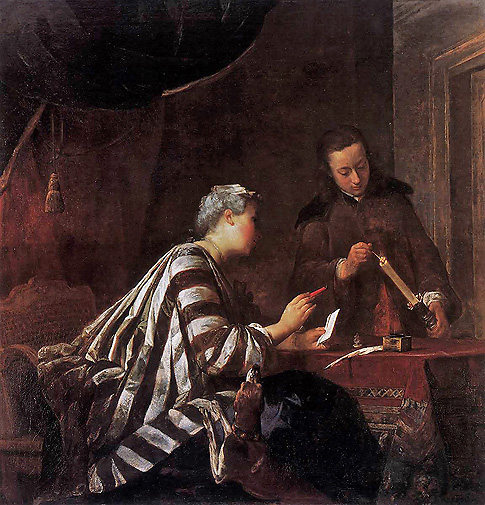
"A Lady Sealing a Letter", Jean-Baptiste-Simeon Chardin, c1732
Tapersticks are not only smaller (often only 5" high) than candlesticks,
but also much rarer than candlesticks.
There was little need for more than one taperstick on a desk.
Thus, they are usually found as singles,
rather than in pairs - as are regular candlesticks.
Whilst the taperstick's primary use was for sealing-wax,
tapersticks were also used for
lighting other candles,
as well as the very long clay tobacco pipes -
thus sometimes being called a
"tobacco candlestick".
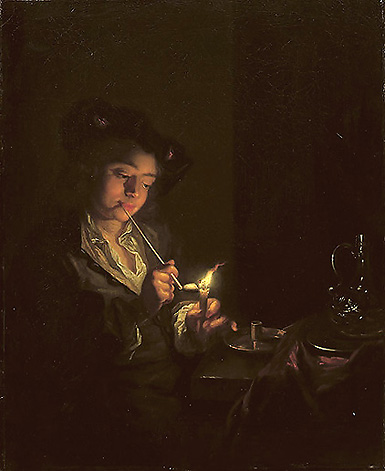
"A Young Man Lighting His Pipe", Arnold Van Boonen (Dutch,16691729)
Often these sealing wax formulas were a bit smelly.
Thus taper waxes were often
perfumed
with essential oils and fragrant balsams.
They were also
colored,
some colors having special meaning.
The most usual choice was a
red-orange
called
"vermillion".
Below is a "Trompe L'oiel with Writing Materials", Edward Collier, c1702 :
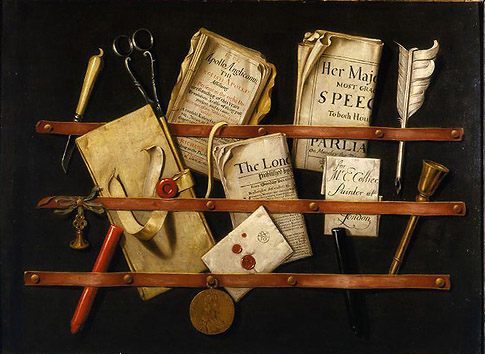
Displayed on a "letter rack", alongside a "sealed" letter and document, are daily newspapers,
a writing quill, a stick of vermillion sealing-wax, a "sealing stamp" and paper knife.
In our gallery, we currently have
TWO "TAPERSTICKS", TWO "DESK SEALS" & A "SEALING WAX HOLDER"
More about them is below :
|
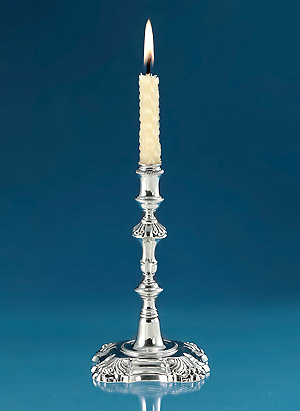 |
|
Fine George II Cast Silver Taperstick,
John Quantock, London 1753
|
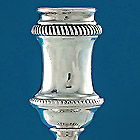 |
An quite fine example,
the spool nozzle with finely gadrooned bandings,
above a stem with shell and leaf knops
and an 'annulated' (flattened) gadrooned knop,
basal fine gadrooning atop the square shaped base,
its four corners with further shell decoration
5.25" High
|
|
|
|
|
|
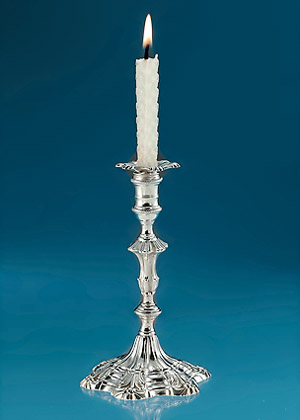 |
|
Early George III Cast Silver Taperstick
William Cafe, London, 1767
|
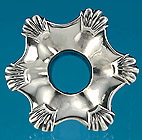 |
The spool form nozzle with fine gadrooning
and a removable shell bobeche (drip pan),
the standard with shell and gadrooned knops
over a sexfoil shell base
5.5" High
|
|
|
|
|
|
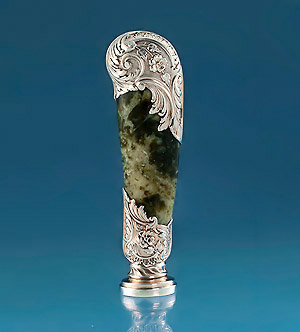 |
|
Silver-Mounted Hardstone Desk Seal
Sampson Mordan, London, 1896, Fully Marked |
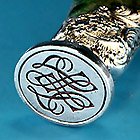 |
Of elongated tapering oval form, the mottled green hardstone
having cast silver foliate scroll mounts to the top
and base, above an oval matrix engraved with
a conjoined cypher monogram / 4" High
|
|
|
|
|
|
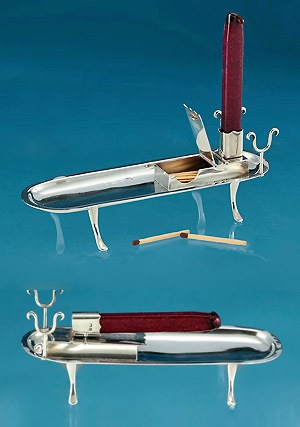 |
|
Unusual Edward VII Silver Desk Compendium
W J Myatt & Co, Birmingham 1903
|
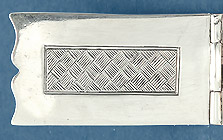 |
Comprising an elongated rounded rectangular tray
having a pair of scrolling pen rests to one end,
and a hinged rectangular sealing-wax holder above
a rectangular vesta case with
engraved hinged cover,
on four splay feet
6.5" Long
|
| |
|
|
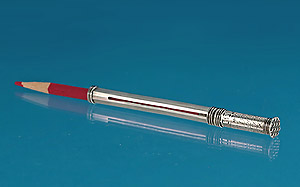 |
|
Late Georgian Silver Telescopic & Perpetual Calendar
Pencil & Seal,England, Early 19th century, Unmarked
|
 |
The slender octagonal cylinder with a reeded slide
below a movable perpetual calendar,
the terminal with a diamond hatched silver seal; 3.25" Long |
Sealing letters with wax has now come back into fashion.
Both seals and sticks are available at many the local craft or stationary stores.
The wax is now available in many colors, including the early vermillion, gold and silver.
Perhaps for your next party?
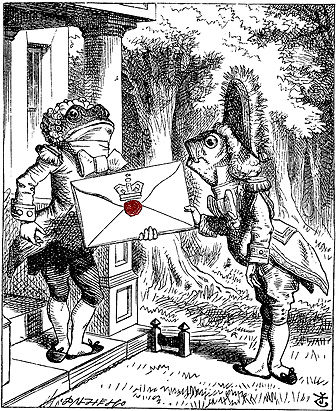
"An Invitation from the Queen"
Additional Notes :
"The Walrus and the Carpenter speaking to the Oysters",
(from "Alice in Wonderland", Lewis Carroll, illustrated by John Tenniel),
The story is a poem, recited to Alice by twins Tweedledum and Tweedledee.
The Walrus and Carpenter went walking on the beach
in the middle of the night (when both sun and moon were shining)...
and attempted to trick some oysters (with no feet)
into "walking" along the beach with them ...
in order to dine upon them.
After hearing the poem, good-natured Alice attempted to decide which
of the two characters (Walrus or Carpenter) might be the more "sympathetic".
She was confused only further by twins Tweedledum and Tweedledee.
She found the situation "a puzzle"...
finally deciding them both to be ..."unpleasant".
*
Followed by our imaginary addendum
....with apologies to Lewis Carroll.
Three Beeswax Candles , found at the Alamannic graveyard,
Oberflacht, Seitingen-Oberflacht, Kreis Tuttlingen, Germany
"A Lady Sealing a Letter", Jean-Baptiste-Simeon Chardin, c1732.
"A Young Man Lighting His Pipe", Arnold Van Boonen (Dutch,16691729)
Edward Collier, active 1662-1708 :
"Trompe-l'il" is French meaning "deceive the eye".
It is a painting technique so expertly executed that the objects appear real and three-dimensional
"The Fish-Footman began by producing from under his arm a great letter,
nearly as large as himself, and this he handed over to the other, saying, in a solemn tone,
'For the Duchess. An invitation from the Queen to play croquet.'"
From
Chapter VI / Pig and Pepper, "Alice in Wonderland",
Lewis Carroll, and illustrated by John Tenniel
And Two Rather Rare "Pairs of Tapersticks" :
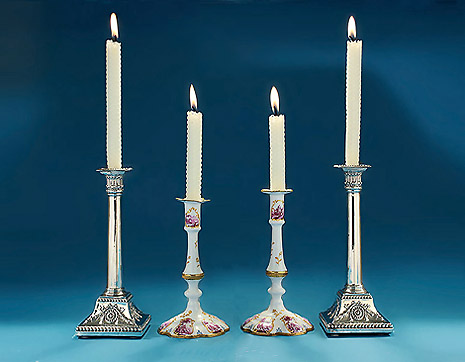
Pair 18th Century Silver Neoclassical Tapersticks
Pair c1760-5 South Staffordshire Enamel on Copper Tapersticks
|